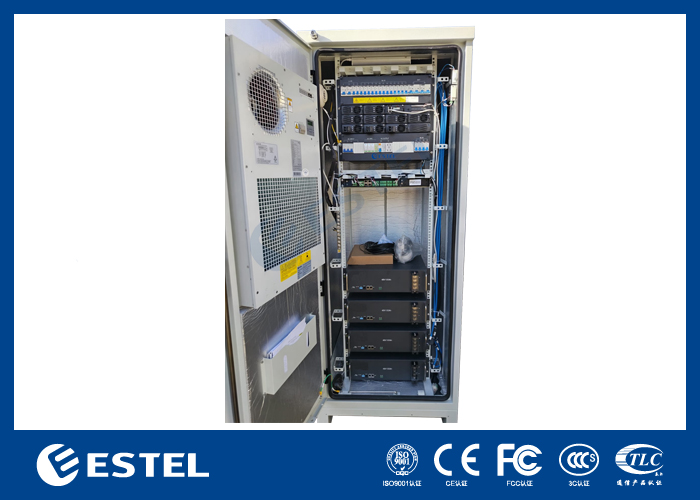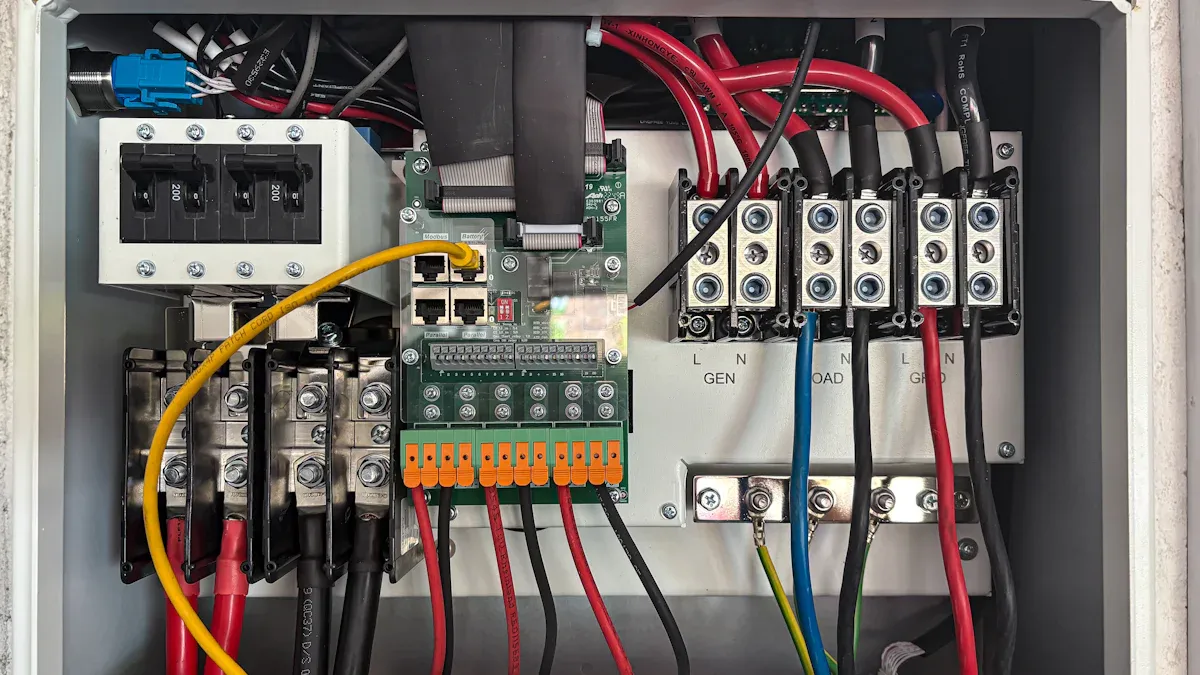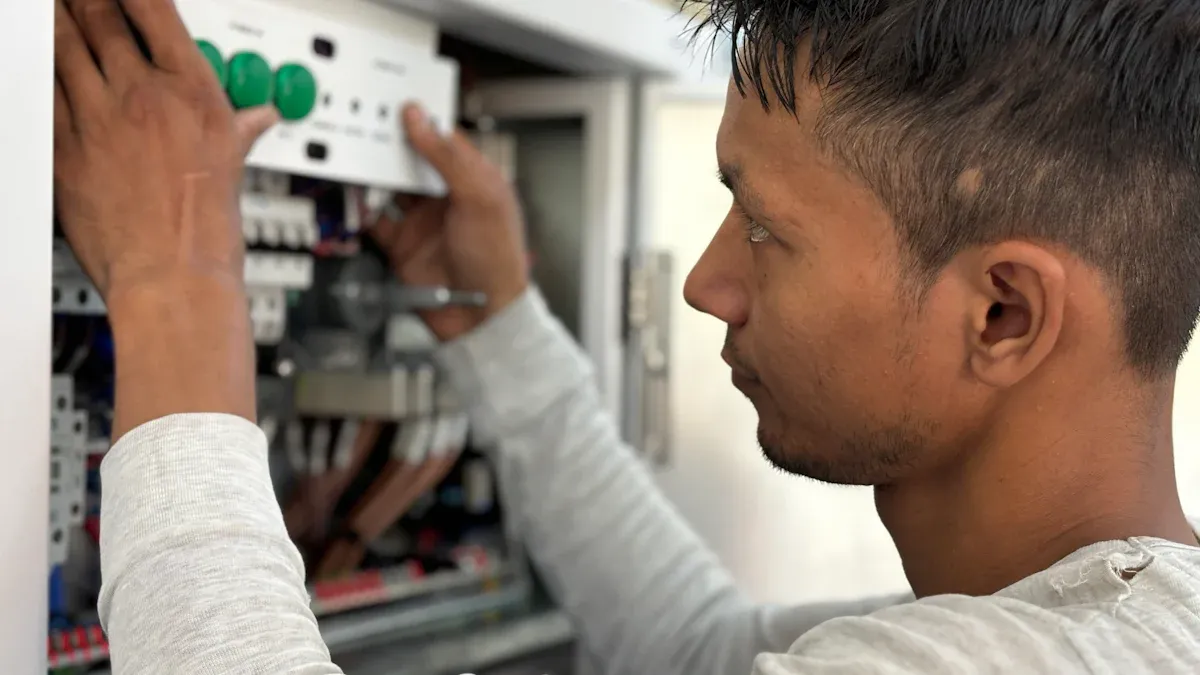How to Keep Battery Storage Cabinets Safe

Preventing battery overheating starts with good temperature control systems, especially when using a battery storage cabinet. Too much heat in a battery can cause fires or explosions. Studies by EPRI show four main reasons for overheating: broken battery cells, bad management systems, poor electrical insulation, and dirty environments. If safety steps are skipped, the risks grow significantly. Over half of businesses have seen batteries overheat or smoke, and 19% have had fires or explosions. By focusing on safety and using strong temperature control systems within a battery storage cabinet, you can lower these risks and keep people and property safe.
Key Takeaways
Keep the temperature steady to stop batteries from overheating. Use tools and sensors to check heat levels.
Pick good-quality batteries that follow safety rules. This lowers failure chances and makes batteries last longer.
Use a Battery Management System (BMS) to check battery health. A BMS stops problems like overheating quickly.
Check your battery cabinet often for any damage. Make sure air can flow properly inside the cabinet.
Store batteries in cool, dry spots with good airflow. Safe storage is very important for keeping batteries safe.
Understanding Thermal Runaway

What is Thermal Runaway?
Thermal runaway happens when a battery makes more heat than it can handle. This creates a dangerous chain reaction. It often starts with small problems, like a broken battery cell or charging the wrong way. As heat increases, the battery's temperature rises quickly. This can cause fires or even explosions. In battery energy storage systems (BESS), thermal runaway is a big safety issue. Knowing about it helps you avoid dangers in your battery storage cabinets.
Once thermal runaway starts, it keeps going on its own. The heat causes chemical reactions inside the battery. These reactions make even more heat. This cycle continues until the battery breaks or someone stops it. Spotting early signs, like unusual heat or swelling, can help you act fast before things get worse.
Causes of Thermal Runaway
Many things can cause thermal runaway in batteries. Knowing these causes helps you prevent problems. Below is a table showing common causes:
Cause | Description |
|---|---|
Too Much Float Charging | Raises battery heat over time, leading to thermal runaway. |
Overcharging | Harms the battery's design, shortening its life and raising risks. |
Hot Surroundings | Hurts battery life when temperatures are too high, causing more heat inside. |
Old Batteries | Older batteries wear out and are more likely to have problems. |
Too much float charging and overcharging are frequent problems. These actions harm the battery's inside parts, making it weaker. Hot surroundings also matter. When it's too warm, the battery can't stay stable, raising the chance of thermal runaway. Older batteries are also at higher risk because they wear out over time.
Fixing these issues lowers the chance of thermal runaway in BESS. Regular checks, proper charging, and keeping batteries cool are key to staying safe.
Steps to Prevent Thermal Runaway
Use Proper Temperature Control
Managing temperature is key to stopping thermal runaway. Advanced systems can help keep batteries at safe temperatures. These systems work even in tough conditions. For example, telecom cabinets use such systems to avoid overheating. This is an important step for bess thermal runaway safety.
Tip: Put temperature sensors in your battery storage cabinet. Sensors give live updates, helping you fix problems early.
Good airflow is also very important. Ventilation systems remove extra heat and keep the cabinet cool. Without airflow, heat builds up and raises the risk of thermal runaway. By managing temperature well, you make your batteries safer and reduce dangers.
Choose High-Quality Batteries
Better batteries are less likely to fail or overheat. Pick batteries that meet safety rules like UL or NFPA standards. These rules mean the batteries passed strict safety tests. For example, good batteries use strong materials that last longer and work better.
Test Type | What It Does |
|---|---|
Strength Testing | Keeps batteries safe from damage by hits or weather changes. |
Safety Certifications | Proves batteries meet safety and performance rules. |
Fire Safety | Makes sure cabinets can stop and handle fires safely. |
High-quality lithium-ion batteries are safer and less likely to overheat. They are built for tough conditions, making them a good choice for your cabinet. Using better batteries not only improves safety but also makes your system last longer.
Add Battery Management Systems (BMS)
A battery management system (BMS) helps watch and control batteries. It checks things like temperature, voltage, and current all the time. This stops problems that could cause thermal runaway. For example, a BMS can spot overheating or overcharging and fix it fast.
Note: A BMS is very helpful for bess thermal runaway safety. It keeps batteries working safely and lowers the chance of failure.
Modern BMS tools also send alerts in real time. This lets you fix issues before they get worse. Adding a good BMS gives your battery cabinet extra safety and reduces risks.
Regular Maintenance and Inspections
Taking care of your battery cabinet is very important. Regular checks help you find problems early before they become big issues like thermal runaway.
Make a plan to check your batteries often. Look for damage like swelling, leaks, or rust. These signs show the battery might overheat. Clean the cabinet to remove dust and dirt. This helps air move freely and keeps the batteries cool.
Tip: Use a list to track what you check. Include tasks like testing voltage, checking wires, and making sure the battery system works well.
Tools can make maintenance easier. A battery monitor shows live data like temperature and voltage. This helps you spot problems early and fix them fast. Regular care not only makes batteries last longer but also lowers the risk of bess thermal runaway.
Avoid Overcharging and Overdischarging
Charging batteries too much or too little can cause problems. Overcharging heats the battery and damages its parts. This raises the chance of thermal runaway. Overdischarging harms the battery and shortens its life.
Follow the maker’s rules for charging. Use a battery system to watch and control charging. These systems keep voltage safe and stop overcharging or overdischarging. They also let you check batteries from far away.
Overcharging heats the battery and raises thermal runaway risks.
Overdischarging weakens the battery and lowers its safety.
Battery systems help keep batteries safe and prevent accidents.
By charging batteries correctly, you make your cabinet safer and avoid thermal runaway.
Ensure Proper Storage Conditions
Storing batteries the right way is very important. Batteries don’t like extreme heat, wetness, or bad weather. Hot places speed up chemical reactions, and wet areas can cause rust or short circuits.
Keep batteries in a cool, dry place with good airflow. Use strong covers to protect them from weather. This is extra important for outdoor setups where weather changes a lot.
Good covers and designs protect batteries from bad weather.
Wet places can cause rust and electrical problems.
Where you store batteries affects how safe they are.
Note: Keep flammable items away from lithium-ion batteries. This adds extra safety against fires.
By storing batteries properly, you lower the risks of bess thermal runaway and keep them working well for a long time.
Add Ways to Remove Heat
Keeping batteries cool is key to stopping thermal runaway. Too much heat can harm batteries, shorten their life, and raise risks. Using ways to remove heat helps keep batteries at safe temperatures, even when working hard.
You can improve cooling by adding better systems and airflow designs. Research shows advanced methods can lower average battery heat by 54.8% and peak heat by 55.2%. These changes make batteries safer and less likely to overheat. Heat removal efficiency can also rise from 75.3% to 87.1%, making it easier to handle extra heat. Faster cooling systems help cabinets adjust quickly to temperature changes, keeping batteries safe during tough tasks.
Here are some tips to manage heat better:
Add Cooling Systems: Use fans, heat sinks, or liquid cooling to cool batteries.
Improve Airflow: Make sure air moves well inside the cabinet to stop heat buildup.
Pick Heat-Resistant Materials: Use materials that stay strong in high heat.
Tip: Place batteries to allow more air to flow around them. This small change can help a lot with cooling.
By using these ideas, you make battery storage safer and lower the chance of thermal runaway.
Build Cabinets with Safety in Mind
The way you design your battery cabinet matters for safety. Good designs protect batteries from damage, bad weather, and people who shouldn’t touch them.
Modern cabinets use strong materials, fireproof designs, and built-in cooling. These features make batteries last longer and work better. For example, fireproof materials can handle high heat, and fire systems can stop fires early.
Feature | What It Does |
|---|---|
Strong Build | Protects batteries from damage, dirt, and bad weather. |
Security Features | Locks and fingerprint access stop people who shouldn’t open the cabinet. |
Cable Organizers | Keeps wires neat, improves airflow, and lowers heat risks. |
Cooling Systems | Keeps batteries at safe temperatures for better performance. |
Following safety rules like UL 94 and NFPA 855 makes cabinets even safer. Fireproof materials and smart fire systems add extra protection against thermal runaway.
To make cabinets safer, try these ideas:
Use Fireproof Materials: Stop fires from spreading inside the cabinet.
Add Fire Systems: Catch and stop fires before they grow.
Organize Cables: Keep wires tidy to improve airflow and stop overheating.
Note: Lockable doors and fingerprint access make sure only the right people can get to the batteries.
By designing cabinets with these safety features, you lower risks and create a better place to store batteries.
Emergency Preparedness for Battery Storage Cabinets

Add Fire Suppression Systems
Fire suppression systems help stop fires from spreading in cabinets. These systems find and control fires early, lowering risks of explosions. For lithium-ion batteries, a two-step method works best. First, use a gas-based system to stop the fire early. Next, add ventilation and water-based systems if the fire continues. Be careful with water, as it can cause short circuits in lithium-ion batteries.
Studies show testing is needed to improve fire suppression for storage systems. Gas systems work well at first but may need extra help to fully stop fires. By using advanced fire suppression systems, you make cabinets safer and reduce fire damage.
Teach Staff Emergency Skills
Training helps staff handle battery emergencies better. Manuals stress teaching fire teams and workers how to manage fires or explosions. Practice drills and regular lessons keep everyone prepared for surprises.
Training should include spotting early fire signs, using fire systems, and safe evacuations. This training improves safety and lowers damage risks. By training your team, you give them the tools to handle emergencies well.
Create an Emergency Plan
An emergency plan lists steps to follow during a crisis. It includes clear roles, communication rules, and updates for new tech or laws. For example, the Incident Command System (ICS) helps manage emergencies without confusion.
Good communication is key. Alerts inside and outside the team tell everyone what to do. Regular drills and training make plans stronger and more useful. By making a solid emergency plan, you protect your cabinet and the people nearby from harm.
Stopping thermal runaway in battery cabinets needs careful planning. Use good temperature control, strong equipment, and regular checks. Research shows special materials like aerogel and mica board stop heat spread. These materials lower the chance of fires and damage. Focus on safety and add features to keep batteries cool and safe. Being ready for emergencies also helps keep systems reliable and worry-free.
FAQ
How should I safely store batteries in a cabinet?
Keep batteries in a cool, dry spot with good airflow. Use fireproof materials and keep flammable things far away. Make sure the cabinet has locks and heat-safe designs.
How often do I need to check my battery cabinet?
Check your cabinet at least once every month. Look for damage, swelling, or leaks. Regular checks help find problems early and stop accidents.
Can I put any battery in a storage cabinet?
No, only use batteries that follow safety rules like UL or NFPA. Good-quality batteries are safer, last longer, and don’t overheat easily.
What should I do if a battery gets too hot?
Quickly unplug the battery and move it to a safe place with airflow. Use a fire system if needed. Call an expert for more help.
Why is a Battery Management System (BMS) needed?
A BMS watches temperature, voltage, and current. It stops overheating, overcharging, and other dangers like thermal runaway. It’s a must-have for safe battery storage.
Tip: Pick a cabinet with a built-in BMS for extra safety.
See Also
Strategies to Protect Outdoor Communication Cabinets from Vandalism
Professional Advice for Safeguarding Cabinets in Risky Locations
Essential Guidelines for Outdoor Maintenance of ESTEL Cabinets
Power Solutions: Energy Storage for ESTEL Telecom Cabinets
In-Depth Risk Assessment Guide for Telecom Cabinet Batteries
CALL US DIRECTLY
86-13752765943
3A-8, SHUIWAN 1979 SQUARE (PHASE II), NO.111, TAIZI ROAD,SHUIWAN COMMUNITY, ZHAOSHANG STREET, NANSHAN DISTRICT, SHENZHEN, GUANGDONG, CHINA

